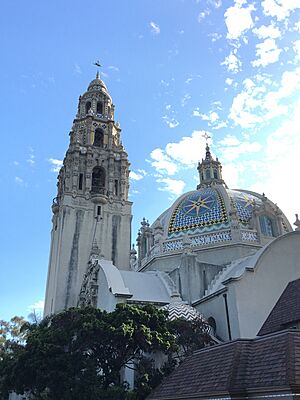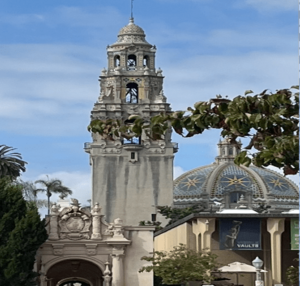Museum of Us facts for kids
 |
|
| Lua error in Module:Location_map at line 420: attempt to index field 'wikibase' (a nil value). | |
| Established | 1915 |
|---|---|
| Location | California Quadrangle 1350 El Prado, Balboa Park San Diego, California, United States |
| Type | anthropological museum |
| Visitors | 220,000 annually |
The Museum of Us is a cool place in Balboa Park, San Diego, California. It's a museum of anthropology, which means it studies people and cultures. The museum is inside some really old and famous buildings called the California Quadrangle.
Contents
Discovering the Museum's Past
The Museum of Us has a long and interesting history. It started over 100 years ago!
How the Museum Began in 1915
The museum first opened its doors in 1915. This was during a big event called the Panama–California Exposition. This exposition celebrated the opening of the Panama Canal. The main exhibit was called "The Story of Man through the Ages." It showed how people lived long ago.
Dr. Edgar Lee Hewett, an archaeologist, helped put this amazing exhibit together. He led trips to find ancient pottery in the American Southwest. He also traveled to Guatemala to find objects and copies of Maya monuments. Another scientist, Aleš Hrdlička, brought items from Africa, Siberia, and Southeast Asia.
Becoming a Permanent Museum
After the big exposition, some citizens wanted to keep these collections. They formed a group called the San Diego Museum Association. Their goal was to turn the exhibit into a permanent museum. Dr. Hewett became its first director.
Over time, the museum added more cool things. This included a collection of weapons and rare items from an ancient Egyptian city called Amarna.
Name Changes Through the Years
The museum has had a few different names!
From Palace of Science to Museum of Man
For a short time in 1935 and 1936, it was called the Palace of Science. This was for another big event, the California Pacific International Exposition. During this time, it showed special exhibits, like many artifacts from Mexico.
In 1942, the museum changed its name to the Museum of Man. This name showed its focus on studying people. Later, in 1978, "San Diego" was added to the name.
Helping During World War II
During World War II, the museum buildings were used as a hospital. All the exhibits and collections had to be stored away safely. After the war, the museum focused on the people of North and South America. Its collections grew a lot from the 1980s to the early 1990s. Today, it has almost two million objects!
Becoming the Museum of Us in 2020
On August 2, 2020, the museum changed its name again. It became the Museum of Us. This new name was chosen to be more welcoming and inclusive for everyone.
Exploring the Museum Buildings
The museum is housed in four original buildings from the 1915 Exposition. These buildings are very special.
The Famous California Tower
The main museum is in the California Building. This building has a tall, famous tower called the California Tower. It's one of San Diego's most important landmarks. The tower was closed for almost 80 years! It reopened in 2015 for the exposition's 100th birthday. You can hear its bells, called a carillon, chime every 15 minutes across Balboa Park.
The California Quadrangle and Tower are listed on the National Register of Historic Places. This means they are very important historical sites.
Other Historic Buildings
The museum also uses three other buildings from 1915. The Gill Administration Building holds offices and an auditorium. It was the very first building built in Balboa Park in 1911.
On the other side of the California Quadrangle is Evernham Hall. This was once the Fine Arts Building. Now it's used for events and temporary exhibits. Right next to it is Saint Francis Chapel, a beautiful Spanish-style chapel.
Amazing Collections to See
The Museum of Us has many incredible collections. They help us learn about different cultures and times.
Ancient Cultures of the Americas
The museum's permanent exhibits focus on the history of the western Americas before Christopher Columbus arrived. You can see items from Native American cultures in Southern California. There are also many artifacts from Mesoamerican civilizations, like the amazing Maya.
Mysteries of Ancient Egypt
The museum also has a collection of Ancient Egyptian items. These include burial masks, small statues, and seven painted wooden coffins. One special piece is a child's coffin from the Ptolemaic period. Only six others like it are known to exist in the world!
In total, the museum has over 100,000 cultural items. It also has 300,000 archaeological items and 25,000 old photographs.
See also
 In Spanish: Museo de Nosotros de San Diego para niños
In Spanish: Museo de Nosotros de San Diego para niños


